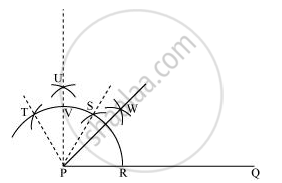Advertisements
Advertisements
Question
Construct an angle of 45° at the initial point of a given ray and justify the construction.
Solution
The below given steps will be followed to construct an angle of 45°.
(i) Take the given ray PQ. Draw an arc of some radius taking point P as its centre, which intersects PQ at R.
(ii) Taking R as centre and with the same radius as before, draw an arc intersecting the previously drawn arc at S.
(iii) Taking S as centre and with the same radius as before, draw an arc intersecting the arc at T (see figure).
(iv) Taking S and T as centre, draw an arc of same radius to intersect each other at U.
(v) Join PU. Let it intersect the arc at point V.
(vi) From R and V, draw arcs with radius more than 1/2RV to intersect each other at W. Join PW.
PW is the required ray making 45° with PQ.

Justification of Construction:
We can justify the construction, if we can prove ∠WPQ = 45°.
For this, join PS and PT.

We have, ∠SPQ = ∠TPS = 60°. In (iii) and (iv) steps of this construction, PU was drawn as the bisector of ∠TPS.
∴ ∠UPS = 1/2 ∠TPS = 60°/2 = 30°
Also, ∠UPQ = ∠SPQ + ∠UPS
= 60° + 30°
= 90°
In step (vi) of this construction, PW was constructed as the bisector of ∠UPQ.
∴ ∠WPQ = 1/2 ∠UPQ = 90°/2 = 45°
APPEARS IN
RELATED QUESTIONS
Construct an angle of 90° at the initial point of a given ray and justify the construction.
Construct the 105° angles and verify by measuring it by a protractor.
Draw a line segment AB of length 5.8 cm. Draw the perpendicular bisector of this line
segment.
Draw a line segment AB and bisect it. Bisect one of the equal parts to obtain a line segment of length `1/2` (AB).
7. Draw a line segment AB and by ruler and compasses1 obtain a line segment of length `3/4`AB.
Draw an obtuse angle, Bisect it. Measure each of the angles so obtained.
Construct the following angles at the initial point of a given ray and justify the construction 90°.
Draw an angle of 110° with the help of a protractor and bisect it. Measure each angle.
Draw an angle of 80° with the help of a protractor. Then construct angles of (i) 40° (ii) 160° and (iii) 120°.
Construct a rectangle whose adjacent sides are of lengths 5 cm and 3.5 cm.
